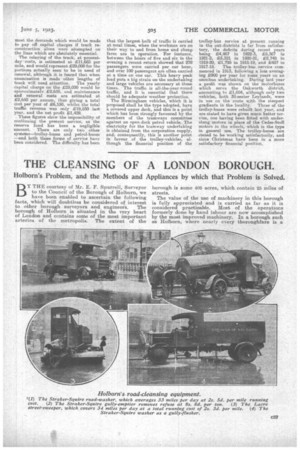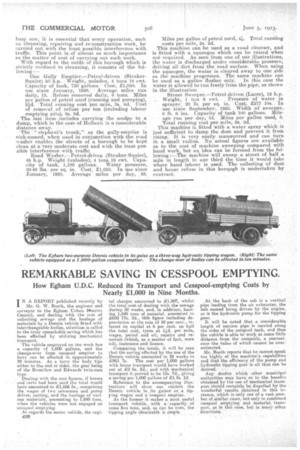THE CLEANSING OF A LONDON BOROUGH.
Page 21

Page 22

If you've noticed an error in this article please click here to report it so we can fix it.
Holborn's Problem, and the Methods and Appliances by which that Problem is Solved.
BY THE courtesy of Mr. E. F. Spurrell, Surveyor to the Council of the Borough of Holborn, we have been enabled to ascertain the following facts, which will doubtless be considered of interest to other borough surveyors and engineers. The borough of Holborn is situated in the very heart of London and contains some of the most important arteries of the metropolis. The extent of the borough is some 405 acres, which contain 25 miles of streets.
The value of the use of machinery in this borough is fully appreciated and is carried as far as it is considered practicable. Most of the operations formerly done by hand labour are now accomplished by the most Unproved machinery. In a borough such as Holborn, where nearly every thoroughfare is a
busy one, it is essential that every operation, such as cleansing, repairing and re-construction work, be carried out with the least possible interference with traffic.. This point is of almost as much importance as the matter of cost of carrying out such work.
With regard to the outfit of this borough which is strictly confined to cleansing, it consists of the following :— One Gully Emptier.—Petrol-driven (StrakerSquike) 50 h.p. 'Weight; uniaden_, 4 tons 18 cwt. Capacity of tank, 750 gallons. Cost, 11,050. In usi?.. since January, 1920. Average miles . run daily, 15. . Refuse removed daily,' 8 tons. Miles per gallon of. petrol used (running. and pumping),
. Total running cost 'per. mile, 6d. Cost of removal of refuse per ton (including labour emptying pits), Ss. '8d. • , The last item.. includes carrying the sludge to a dully, which in the case of Holborn is a considerable distance' away. •
." elephant's .trunk," as the gully-emptier is nick-named, when used in conjunction with the road waSher enables, the streets of a borough to be kept clean at a 'very moderate cost and with the least possible interference with traffic.
Road Washer.—Petrol-driven (Straker-Squire), 45 hp. Weight (unladen), 4 tons 19 cwt. Capa
city of tank, 1,106 gallons. Water pressure, 30-40 lbs.per sq. in. Cost, £1,050. In use since January, 1920. Average miles per day, 33. Miles per gallon of petrol used, 4,1. Total running costs per mile, 2s. 5d. This machine can be used as a road cleanser, and is fitted with it squeegee which can be raised when not' required. As seen from one of our illustrations, the water is discharged under considerable pressure, driving all dirt frond the road surface. When using the squeegeei the water is cleared away to one side as the machine progresses. The same machine can be used as a glitter flusher only. In this case the water is allowed to run freely from the pipe, as shown in the illustration.
• Street Sweeper.—Petrol-driven (Lacre),
Weight, 1 ton 6 cwt. Pressure of water in sprayer, 20 lb. per sq. in. Cost, 2577 108. In use since September, 1920. Width of sweeper, 6 ft. 6 ins. Capacity of tank 100 gallons. Mile'age. run per day,34. Miles per gallon used, 5. Total running cost per mile; 2s. 3d.
This machine is fitted with a water spray which is just sufficient to damp the dust and prevent it from rising. It is very easily manoeuvred and can turn in a small radius. No actual figures are available as to the cost of machine sweeping compared with hand work, but an idea can be formed from the following :—The machine will sweep a street of half a mile in length in one third the time it would take where hand labour is used. The collecting of dust and house refuse in this borqugh is undertaken by contract.








































